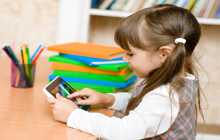Blended learning is successful with young students if modified for their unique learning needs
 Implementing blended learning in the earliest grades can have an incredibly positive impact on young students if educators follow a “transitional” blended learning model that focuses on active and intentional technology use.
Implementing blended learning in the earliest grades can have an incredibly positive impact on young students if educators follow a “transitional” blended learning model that focuses on active and intentional technology use.
A transitional blended learning model follows, with a few tweaks, a traditional rotational model as outlined by the Clayton Christensen Institute: students move on a fixed schedule between digital learning (in which they have some control over time, place, path, and/or pace) and traditional teacher-led classroom instruction, said Barker Davis, senior vice president of business development for AWE, during an edWeb webinar.
This model, Davis said, is the best blended learning model for preK-2 students because of its engagement, focus, and personalization.
(Next page: Top components of a blended learning program for preK-2 students)
While a virtual learning environment is quickly becoming the norm among middle and high school students, Davis said students in the preK-2 grades need socialization and behavior modeling, which is why a transitional blended learning model works well for them—students still use digital technologies to enhance learning, but they are eased into blended learning in a way that lets them remain in group settings to develop social and emotional skills.
“Socialization is critical for that age group—it’s a critical element of early learning that cannot be done in a remote environment,” he said.
Components of a transitional rotational blended learning model include:
- Teacher-directed prescriptive learning that is intentional and likely standard- or skill-driven
- Collaborative learning in the form of gaming, project-based challenges, or other learning that occurs in small groups while engaging children using digital tools
- Self-directed explorative learning, in a classroom or a lab, which is very retention-based, gives students control and choice, and is “sticky” in nature, meaning it is highly engaging and motivating
- Teacher individualized prescriptive learning in a class or lab is the “nuts and bolts” of learning, and is an important part of a blended learning and content solution because it focuses on the intentionality of learning
- Out-of-school learning with parental involvement can be difficult to achieve based on parental effort and at-home internet and technology access, but educators should attempt it despite these challenges
In order to get started, Davis recommended that educators:
- Evaluate resources and needs, such as what they want to achieve, what resources are already in place to help progress toward that goal, and what resources are needed
- Start small, with one or two digital rotations
- Pick a specific subject area
- Select a blended learning solution that aligns with resources and needs
- Allocate adequate time for blended learning—approximately two to four hours per student, per week, per rotation
- Set target goals and expectations
- Set a professional development and implementation plan
- Involve parents, both in plans and via out-of-school time
- Track and react to data feedback
- Evaluate progress using assessments, and adjust based on results
Implementing a blended learning program is not without challenges, particularly at the preK-2 level, Davis noted. Top challenges are finding high-quality content, using content and the blended learning program with intention, and making sure security is up to par.
Content: Educators will need a wide variety of content to meet students’ different learning speeds and learning styles. Finding the right kind and combination of digital content can prove difficult. Explorative content is absolutely essential, Davis said, because it is among the most impactful content out there.
Blended learning environments for young students also should include collaborative content, because this helps young students develop teamwork skills and social learning skills—especially when many of these young learners are interacting with others in academic environments for the first time.
Intention: Searching for learning solutions, and not platforms or devices, will help educators ensure that students are actively learning when they do use digital technology and tools in a blended learning program. One pitfall of blended learning with younger students is that children easily veer off-task, and educators must be vigilant in this area.
Security: This challenge is a given, but is still important. When children are exposed to online content of any kind, they’ll be using a browser, which exposes them to some kind of IT security risk. Inevitably, a child breaks through security settings, and while it speaks to persistence and creativity of digital natives, it does expose young children to possible security risks. Mitigating those risks and staying one step ahead of online threats is key.
- 4 ways to support work-based learning - April 23, 2024
- Prioritizing inclusivity in game-based learning - April 22, 2024
- Friday 5: Universal Design for Learning - April 19, 2024

